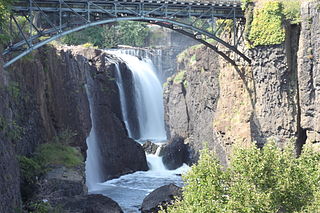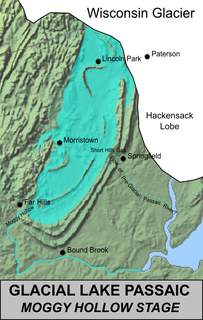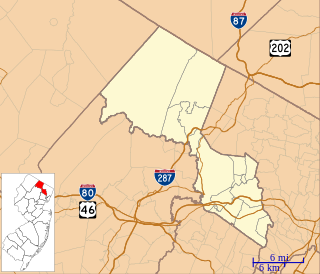
Passaic County is a county in the U.S. state of New Jersey that is part of the New York metropolitan area.
Scouting in New Jersey has a long history, from the 1910s to the present day, serving thousands of youth in programs that suit the environment in which they live. The second Boy Scouts of America National Headquarters was in North Brunswick, although it was referred to in BSA publications as being in neighboring New Brunswick.

Little Falls is a township in Passaic County, New Jersey, United States. The township was named for a waterfall on the Passaic River at a dam near Beattie Mill.

Totowa is a borough in Passaic County, New Jersey, United States. As of the 2010 United States Census, the borough's population was 10,844, reflecting an increase of 912 (+9.2%) from the 9,892 counted in the 2000 Census, which had in turn declined by 285 (-2.8%) from the 10,177 counted in the 1990 Census.

Wayne is a township in Passaic County, New Jersey, United States, located less than 20 miles (32 km) from Midtown Manhattan, and is home to William Paterson University. As of the 2010 United States Census, the township had a total population of 54,717, reflecting an increase of 648 (+1.2%) from the 54,069 counted in the 2000 Census, which had in turn increased by 7,044 (+15.0%) from the 47,025 counted in the 1990 Census.
U.S. Route 46 (US 46) is an east–west U.S. Highway completely within the state of New Jersey, running for 75.34 mi (121.25 km), making it the shortest signed, non-spur U.S. Highway. The west end is at an interchange with Interstate 80 (I-80) and Route 94 in Columbia, Warren County on the Delaware River. The east end is in the middle of the George Washington Bridge over the Hudson River in Fort Lee, Bergen County while the route is concurrent with I-95 and US 1-9. Throughout much of its length, US 46 is closely paralleled by I-80. US 46 is a major local and suburban route, with some sections built to or near freeway standards and many other sections arterials with jughandles. The route runs through several communities in the northern part of New Jersey, including Hackettstown, Netcong, Dover, Parsippany-Troy Hills, Wayne, Clifton, Ridgefield Park, Palisades Park, and Fort Lee. It crosses over the Upper Passaic River at several points. The road has been ceremonially named the United Spanish–American War Veterans Memorial Highway.

The Passaic River is a river, approximately 80 mi (129 km) long, in northern New Jersey in the United States. The river in its upper course flows in a highly circuitous route, meandering through the swamp lowlands between the ridge hills of rural and suburban northern New Jersey, called the Great Swamp, draining much of the northern portion of the state through its tributaries. In its lower portion, it flows through the most urbanized and industrialized areas of the state, including along downtown Newark. The lower river suffered from severe pollution and industrial abandonment in the 20th century. In April 2014, the U.S. Environmental Protection Agency (EPA) announced a $1.7 billion plan to remove 4.3 million cubic yards of toxic mud from the bottom of lower eight miles of the river. It is considered one of the most polluted stretches of water in the nation and the project one of the largest clean-ups ever undertaken.

Lake Passaic was a prehistoric proglacial lake that existed in northern New Jersey in the United States at the end of the last ice age approximately 19,000–14,000 years ago. The lake was formed of waters released by the retreating Wisconsin Glacier, which had pushed large quantities of earth and rock ahead of its advance, blocking the previous natural drainage of the ancestral Passaic River through a gap in the central Watchung Mountains. The lake persisted for several thousand years as melting ice and eroding moraine dams slowly drained the former lake basin. The effect of the lake's creation permanently altered the course of the Passaic River, forcing it to take a circuitous route through the northern Watchung Mountains before spilling out into the lower piedmont.
TD Banknorth, formerly Banknorth, was a wholly owned subsidiary of the Toronto-Dominion Bank which conducted banking and insurance activities, primarily serving the northeastern area of the United States, headquartered in Portland, Maine. The bank became TD Bank, N.A. on May 31, 2008.
The Morris and Essex Railroad was a railroad across northern New Jersey, later part of the main line of the Delaware, Lackawanna and Western Railroad.

Passaic Valley Regional High School is the name of both a public school district and regional high school for students in ninth through twelfth grades from a district comprising Little Falls, Totowa and Woodland Park, three communities in Passaic County, New Jersey, United States.
The Totowa Borough Public Schools are a comprehensive community public school district, serving students in pre-kindergarten through eighth grade in Totowa, in Passaic County, New Jersey, United States.
The Little Falls Township Public Schools is a community public school district that serves students in kindergarten through eighth grade from Little Falls, in Passaic County, New Jersey, United States.
Valley National Bancorp, doing business as Valley Bank, is a regional bank holding company headquartered in Wayne, New Jersey with approximately $30 billion in assets. Its principal subsidiary, Valley National Bank, currently operates over 230 branch locations in northern and central New Jersey, the New York City boroughs of Manhattan, Brooklyn, and Queens, as well as Long Island, Florida, and Alabama. Valley Bank holds approximately $29 billion in assets.

The Gateway Region is the primary urbanized area of the northeastern section of New Jersey, United States. It is anchored by Newark, the state's most populous city, and is often also known as the Newark metropolitan area.

WSFS Financial Corporation is a financial services company. Its primary subsidiary, WSFS Bank, is the largest and longest-standing locally managed bank and trust company headquartered in Delaware and the Greater Delaware Valley. WSFS operates from 147 offices located in Delaware (49), Pennsylvania (72), New Jersey (24), Virginia (1) and Nevada (1) and provides financial services including commercial banking, retail banking, cash management and trust and wealth management.
Hudson City Bancorp, Inc., based in Paramus, in the U.S. state of New Jersey, was a bank-holding company for Hudson City Savings Bank, its only subsidiary, then the largest savings bank in New Jersey and one of the oldest banks in the United States, with US$50 billion in assets. It is now a fully publicly held entity and a member S&P 500 stock market Index. In 2005, its US$3.93 billion secondary offering of common stock was the largest in United States banking history. At the time, it was also the seventh largest domestic public offering in United States history The bank avoided the excesses of the housing boom and was labeled "best bank of 2007" by Forbes. M&T Bank agreed to acquire Hudson City on August 27, 2012.

The Montclair-Boonton Line is a commuter rail line of New Jersey Transit Rail Operations in the United States. It is part of the Hoboken Division. The line is a consolidation of three individual lines: the former Delaware, Lackawanna & Western Railroad's Montclair Branch, which ran from Hoboken Terminal to Bay Street, Montclair; the Erie Railroad's Greenwood Lake Division, which originally ran from the Erie's Jersey City Terminal to Greenwood Lake, NY; and the former Lackawanna Boonton Line, which ran from Hoboken to Hackettstown, New Jersey. The Montclair-Boonton line was formed when the Montclair Connection opened on September 30, 2002. The line serves 28 active rail stations in New Jersey along with New York Pennsylvania Station. It crosses through six counties, serving six stations in the township of Montclair, two in the town of Bloomfield, and one in the city of Newark. Trains along the Montclair-Boonton Line heading eastward usually originate at Hackettstown, Mount Olive, Lake Hopatcong, Dover, or Montclair State University, bound for either Hoboken Terminal or New York Penn Station. On system maps the line is colored light red and its symbol is a bird.









